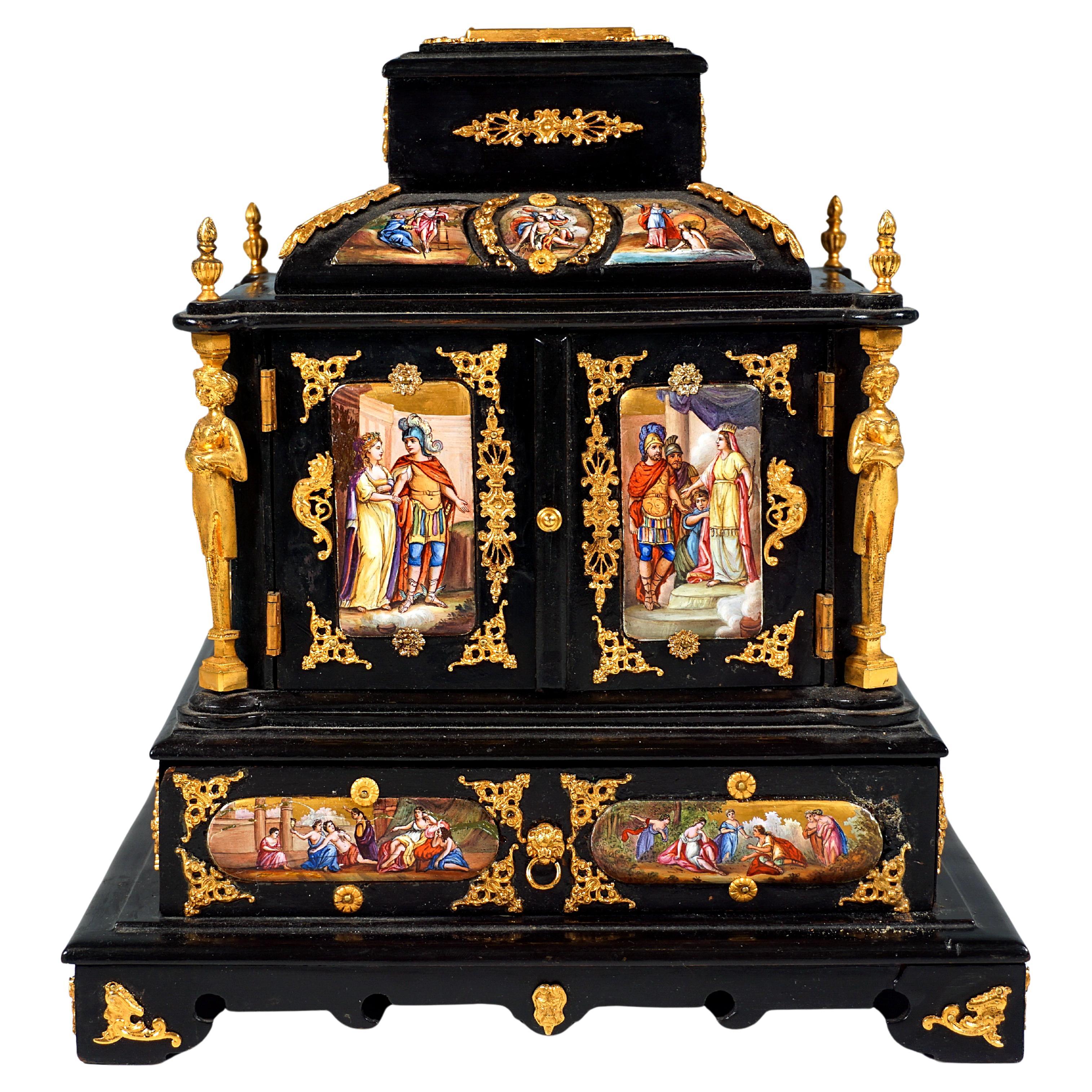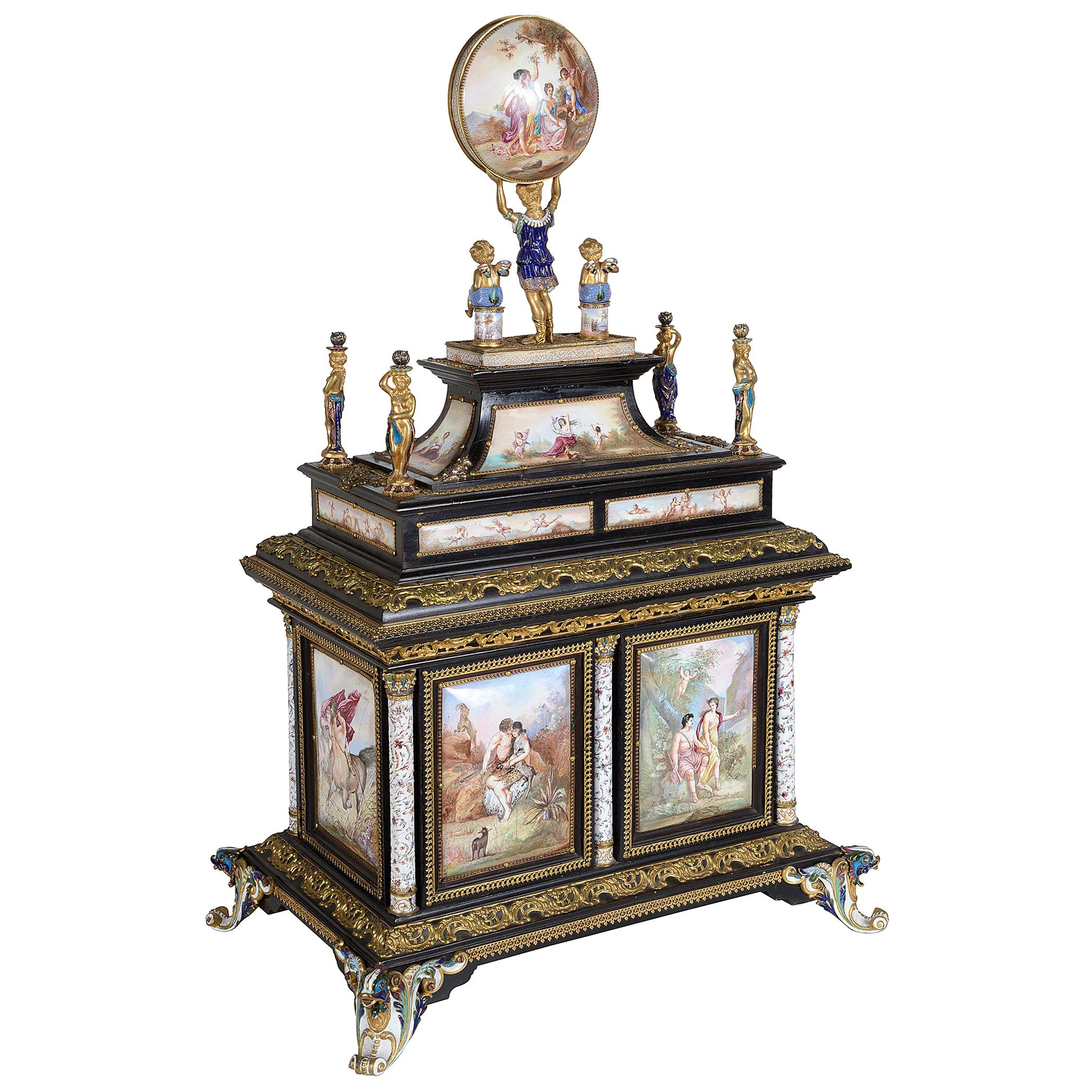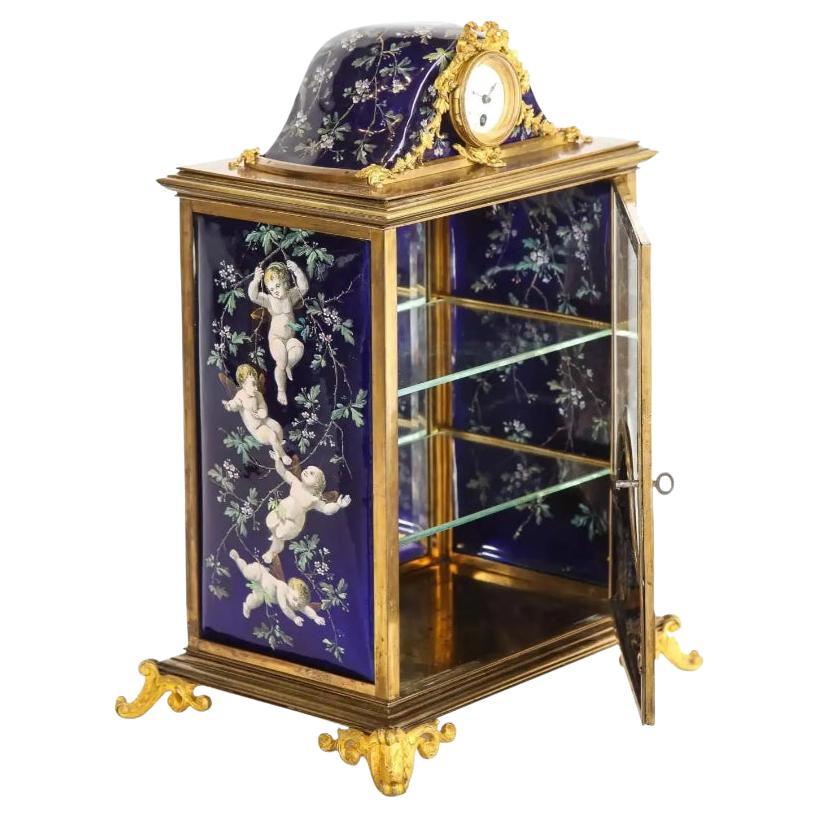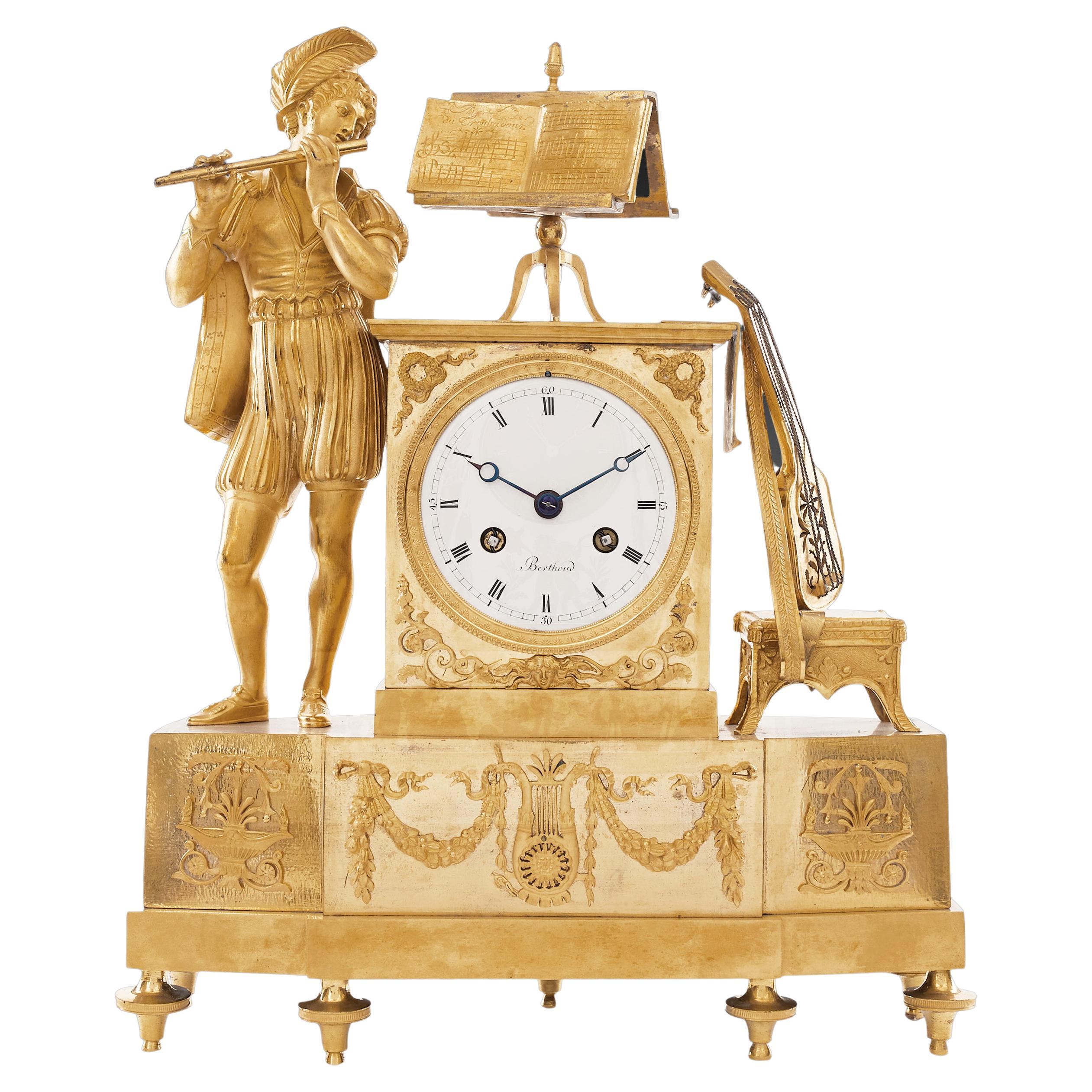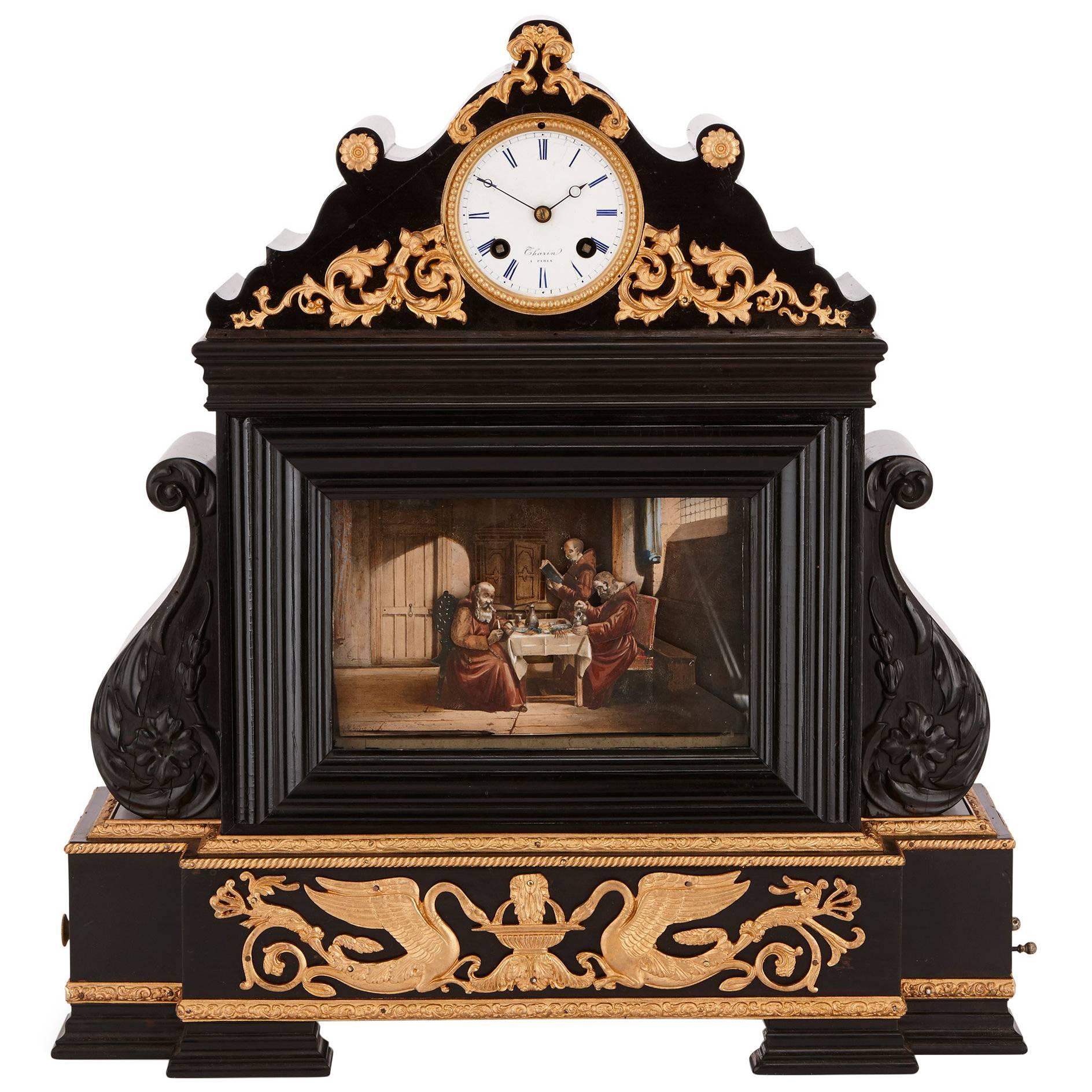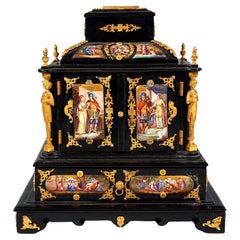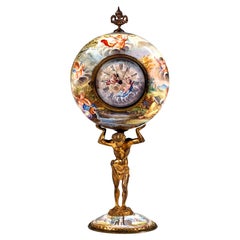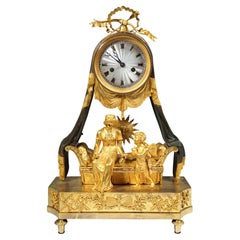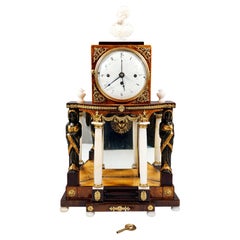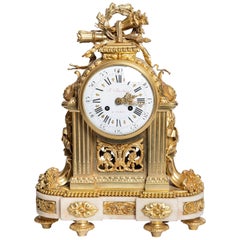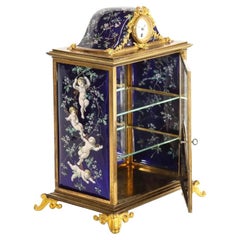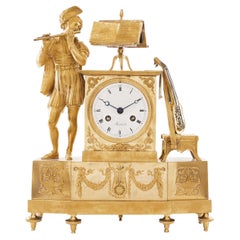Items Similar to Noble Viennese Jewel Case With Enamel Paintings, Bronze Figures & Clock, Ca 1870
Video Loading
Want more images or videos?
Request additional images or videos from the seller
1 of 20
Noble Viennese Jewel Case With Enamel Paintings, Bronze Figures & Clock, Ca 1870
$26,573.76
£20,005.97
€22,500
CA$36,607.10
A$40,997.65
CHF 21,391.90
MX$500,768.63
NOK 272,167.22
SEK 256,550.22
DKK 171,273.05
About the Item
Elaborately decorated casket from noble origin in excellent condition:
Wooden body stained black in the shape of a shrine with a stepped structure on a rectangular base, standing on four square wooden feet, a recessed base with an integrated drawer running across the entire width and depth, above which is a stepped, recessed square box element with two hinged doors at the front, inside the box are three drawers, two attached aedicules on the sides - niches covered with arched elements with pairs of blue enamelled columns in front - housing two faun statuettes made of gold bronze and each set with a small owl statuette, cover
projecting over the box element with four baluster-shaped fittings at the corners, centrally arched stepped roof structure crowned with a four-pass wooden box with clock, on top of which is a fully sculpted putto in fish costume.
All surfaces covered with plaques of various sizes and shapes with the finest coloured enamel painting, the doors also on the inside, as well as the front sides of the hidden drawers.
Depiction of mythological scenes, arabesque-shaped fittings and leaf decorations between and around the plaques, the plaques framed by elaborate brass zigzag bands.
All fittings and figurative elements are made of brass and gilded bronze.
Excellent and detailed quality of workmanship, as is typical of Viennese enamel art.
Clock from Ferdinand Berthoud à Genève, Switzerland, dial with combined time display: overall dial with second scale and large, delicate central indicator, integrated with three additional displays showing hours (bottom), weekdays (top right, French) and month (top left, days 1-31), working movement, winding key included.
Ferdinand Berthoud (1727–1807) was a scientist and master watchmaker. He was born in Plancemont, Switzerland, and spent most of his life in Paris, where he eventually became 'watchmaker to the king and the navy'. He will forever be associated with the manufacture of marine chronometers, which were used in the 18th century to determine the longitude of ships at sea. In 2006, Karl-Friedrich Scheufele, co-president of Chopard and an avid collector of watch artefacts, acquired the Ferdinand Berthoud name. The revived company,
Chronométre Ferdinand Berthoud, launched its first model, the FB1, in 2015.
Dedication in the bottom large drawer, cardboard label affixed with black ink: 'Von Achduke Franz Ferdinand Graf Ludwig Joseph Maria of Austria Zum Sophie Maria Josephine A. C. von Chatkow und Wognin. 1913.'('From Archduke
Franz Ferdinand Count Ludwig Joseph Maria of Austria to Sophie Maria Josephine A. C. von Chatkow und Wognin. 1913.')
Archduke Franz Ferdinand Carl Ludwig Joseph Maria of Austria-Este (born 18 December 1863 in Graz; died 28 June 1914 in Sarajevo) was a member of the House of Habsburg-Lorraine and heir to the throne of Austria-Hungary from
1896. He and his wife, Duchess Sophie von Hohenberg, were killed in the Sarajevo assassination by Bosnian Serb nationalist Gavrilo Princip. The assassination triggered the July Crisis, which led to the First World War shortly afterwards.
Sophie Maria Josephine Albina Countess Chotek von Chotkowa und Wognin (born 1 March 1868 in Stuttgart; died 28 June 1914 in Sarajevo), Princess from 1900 and Duchess of Hohenberg from 1909, was a Bohemian noblewoman and wife of the Austrian heir to the throne Franz Ferdinand. She was killed with him in the Sarajevo assassination that triggered the First World War. She was the ancestor of the Dukes and Princes of Hohenberg.
Viennese / Austrian manufactory
Woodwork, enamel painting, bronze & brass casting, hand-crafted and
hand-painted
Made around 1870/1880
Dimensions:
Heigth: 48,0 cm / 18.89 in
Width: 35,5 cm / 13.97 in
Depth: 27,0 cm / 10.62 in
Condition:
Very well maintained condition.
Clock in working order, a serrated frame element is missing on the left side, keys for box and clock are available.
- Creator:Ferdinand Berthoud (Clockmaker),Viennese Manufactory (Manufacturer)
- Dimensions:Height: 18.9 in (48 cm)Width: 13.98 in (35.5 cm)Depth: 10.63 in (27 cm)
- Style:Other (Of the Period)
- Materials and Techniques:
- Place of Origin:
- Period:
- Date of Manufacture:circa 1870-1880
- Condition:Wear consistent with age and use.
- Seller Location:Vienna, AT
- Reference Number:1stDibs: LU1014445425032
About the Seller
5.0
Platinum Seller
Premium sellers with a 4.7+ rating and 24-hour response times
Established in 1988
1stDibs seller since 2013
304 sales on 1stDibs
Typical response time: 1 hour
- ShippingRetrieving quote...Shipping from: Vienna, Austria
- Return Policy
Authenticity Guarantee
In the unlikely event there’s an issue with an item’s authenticity, contact us within 1 year for a full refund. DetailsMoney-Back Guarantee
If your item is not as described, is damaged in transit, or does not arrive, contact us within 7 days for a full refund. Details24-Hour Cancellation
You have a 24-hour grace period in which to reconsider your purchase, with no questions asked.Vetted Professional Sellers
Our world-class sellers must adhere to strict standards for service and quality, maintaining the integrity of our listings.Price-Match Guarantee
If you find that a seller listed the same item for a lower price elsewhere, we’ll match it.Trusted Global Delivery
Our best-in-class carrier network provides specialized shipping options worldwide, including custom delivery.More From This Seller
View AllViennese Jewel Case With Enamel Paintings Bronze & Brass Fittings, Ca 1870/1880
By Viennese Manufactory
Located in Vienna, AT
Elaborately decorated casket in excellent condition:
Black-stained wooden body in the shape of a shrine with a stepped structure on a rectangular base, a recessed plinth area above t...
Category
Antique 1870s Austrian Other Cabinets
Materials
Brass, Bronze
Viennese Bronze Enamel Table Clock With Atlas Carrying The Case, Circa 1880
By Viennese Manufactory
Located in Vienna, AT
Artfully decorated fire-gilded and enamelled bronze clock by a Viennese master:
Fully sculpted bronze Atlas on a slightly curved oval base supporting a round clock case, all surfaces...
Category
Antique 1880s Austrian Other Sterling Silver
Materials
Enamel, Bronze
French Ormolu Mantle Clock, Pendule 'Lit à Baldaquin', Paris, Around 1790
Located in Vienna, AT
Excellent fire-gilded Empire bronze mantel clock: structure in the form of a rectangular, stepped pedestal that tapers at the front corners, on four spindle feet, with relief ornamen...
Category
Antique 1790s French Louis XVI Table Clocks and Desk Clocks
Materials
Bronze
Viennese Empire Portal Clock With Caryatids And Gilded Fittings, Around 1810
By Viennese Manufactory
Located in Vienna, AT
Complete Vienna clock on six stocky ball feet made of alabaster, architecturally structured wooden case with fruitwood veneers in the shape of a portal, steps in front flanked by two...
Category
Antique 1810s Austrian Empire Sterling Silver
Materials
Alabaster, Brass
Vienna Enamel Table Clock Silver Nacre Enamel Onyx Semiprecious Stones
By Viennese Manufactory
Located in Vienna, AT
Stunning Viennese enamel vintage table clock - made of:
-- silver
-- nacre
-- enamel (excellently chiselled)
-- onyx
-- semiprecious stones
Attention: The table clock is par...
Category
Antique 1870s Austrian Victorian Table Clocks and Desk Clocks
Materials
Onyx, Silver, Enamel
Viennese Silver Historicism Splendour Clock With Musical Movement, Around 1880
By Viennese Manufactory
Located in Vienna, AT
Artfully decorated silver gilded table clock by a Viennese master:
Flat, rectangular corpus containing the musical mechanism, standing on four elaborately decorated volute feet attac...
Category
Antique 1880s Austrian Other Sterling Silver
Materials
Amethyst, Malachite, Gold Plate, Silver, Enamel
You May Also Like
Gilt Bronze and Marble Mantel Clock, Signed F. Berthoud, Paris
By Ferdinand Berthoud
Located in Buenos Aires, Buenos Aires
Gilt bronze and marble mantel clock, signed F. Berthoud, Paris, France, early 19th century.
Clock works.
Category
Antique Early 19th Century French Louis XVI Mantel Clocks
Materials
Marble, Bronze
Impressive 19th Century Viennese Enamel Table Cabinet
Located in Brighton, Sussex
A very impressive 19th century Viennese enamel table cabinet having gilded ormolu semi clad maidens surrounding two cherubs and a figure supporting a watch case.
Enamel panels aroun...
Category
Antique 1860s Austrian Jewelry Boxes
Materials
Enamel, Ormolu
French Bronze and Limoges Enamel Jewelry Vitrine Cabinet with Clock
Located in Long Island City, NY
A french bronze and limoges enamel jewelry vitrine cabinet with clock, 19th century.
hand painted with beautiful cobalt blue panels of cherub...
Category
Antique 19th Century French Table Clocks and Desk Clocks
Materials
Bronze, Enamel
Mantel Clock 19th Century Styl Empire by Ferdinand Berthoud À Paris
Located in Warsaw, PL
Ormolu bronze mantel clock flanked by a troubadour and musical instruments, signed 'Ferdinand Berthoud a Paris'.
The end of the 18th and beginning of the 19th century was a crucial time in which new technological advances helped to make watches more accurate and more portable. During the 1790s, the production of gilded bronze increased considerably as working conditions improved. The freedom of trade initiated by the French Revolution allowed many casters to develop large factories. The new factory environment gave them a chance to execute all stages of bronze work including drawing, casting, gilding, assembly, and trade of art objects. While the bronzers took creative liberty in creating all kinds of clocks in contrast to the noble and rigorous structure carried by the movement of neoclassicism. Under the reign of Empire, the case designs started gradually to develop away from a proportionate and strict classicism towards a baroque style and revival style. The rediscovery of medieval civilization was one of the intellectual curiosities of the beginning of the 19th century, with much input from the Ancien Régime and its institutions, rites and the medieval churches in which family ceremonies occurred.
This early nineteenth-century figural mantel clock is surmounted by a medieval musician. To be more precise, it is a french troubadour. Troubadours were known for composing and performing lyric poetry for the nobility back during medieval times. The clock is featuring a chiselled bronze troubadour, dressed in medieval fashion while holding a flute, playing a tune from sheet music called "Du Troubadour" that is resting on top of the rectangular clock case. In addition to that, the clock features a gilt bronze lute or vielle resting on a small stool on the opposite side of the clock’s case. The white enamel dial features the inscription Berthoud and is underlined by a bronze entourage chiselled with palmette motif, plus encompassed by c-scrolls and wreaths. The original hands are in blued steel and encircled by Roman numerals indicating hour next to Arabic numerals indicating minutes.
The small details that adorn the hexagonal plinth are reliefs, depicting two water fountains or basins on both sides with a lyre in between. The sculpted image of a lyre raised above the background features also foliage garlands tied on top with ribbons. The clock rests on seven spinning feet.
The clock was made in the well-known workshop of the Berthoud’s family that was recognized for their excellent work by the King.
Berthoud Clockmakers History.
Ferdinand Berthoud was a horologist and author of extensive treatises on timekeeping as well as a Swiss clockmaker serving the king of France, that produced many marine clocks, including a weight-driven version that inspired the first American sea-going clock. He was born in Plancemont, Switzerland, the son of an architect and judiciary. In 1741 he began a three-year apprenticeship as a clockmaker under his brother, Jean-Henri. He made his first marine chronometer in 1754 (sent for trial in 1761) and in 1764 was appointed a member of the Royal Society, London and Horloger Mécanicien de Sa Majesté et de la Marine ayant l'inspection de la construction des Horloges Marines. In 1769, Ferdinand Berthoud sent for his nephew Pierre-Louis Berthoud (1754–1813), commonly known as Louis Berthoud, a talented young watchmaker and clockmaker, inviting him to come to Paris from Couvet, Switzerland, to pursue his apprenticeship. Louis helped Ferdinand manufacture and repair the sea clocks...
Category
Antique Late 18th Century French Louis XVI Mantel Clocks
Materials
Bronze
19th Century French musical automaton clock
Located in London, GB
This fine, antique mantel clock is constructed in ebonised wood by the renowned Parisian maker of automata, Xavier Tharin (French, active mid 19th Century). The clock face is set onto a curled, stylized pediment atop the clock case. The face is of white enamel, featuring black Roman numerals and signed 'Tharin a Paris', and is bordered in beaded ormolu. The pediment in which the face is set is decorated with ormolu mounts of stylized acanthus leaf form. The pediment is set onto a rectangular frame of ebonised wood, inside which is set a musical automaton...
Category
Antique 19th Century French Napoleon III Mantel Clocks
Materials
Enamel, Ormolu
Viennese enamel table cabinet, 19th Century
Located in Brighton, Sussex
A wonderfully impressive early 19th Century Viennese enamel, ebonised table cabinet. Mounted with a clock, the case decorated with classical mythological romantic scenes, also plaque...
Category
Antique Early 19th Century Austrian Neoclassical Revival Cabinets
Materials
Enamel, Ormolu
More Ways To Browse
18th Century Jewels
Antique Enamel Painting
Cased Model Ship
Antique Wooden Scale
Antique Bronze Balusters
Antique Kitchen Scales
Antique Duchess
Antique House Plaques
Antique Standing Scale
Dior Clock
Watchmakers Furniture
Twos Company Clock
King Throne
French Enamel Watch
Antique Black Wood Stain
Cabinet With Clock
Antique Wooden Storage Box Boxes
Antique Wooden Storage Box
